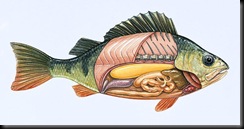Scientists have found that certain cells in a hybrid striped bass commonly available in the United States contain a new family of antibiotics. Edward Noga and Umaporn Silphaduang, both of North Carolina State University in Raleigh, have named the antibiotics "piscidins" for the Latin word for fish, pisces.
The piscidins are actually tiny protein antibiotics produced by mast cells, which are found in the immune systems of all vertebrates.
Many organisms produce their own antibiotics to protect themselves against disease-causing microbes. More than a decade ago, for example, researchers discovered that frogs oozed a new class of natural antibiotics in their skins, which were later named "magainins." Crocodiles produce unique antibiotics that circulate in their blood stream.
For years there has been considerable interest in discovering new antibiotics that can kill a variety of human pathogens. A growing number of bacteria are becoming resistant to existing antibiotics, and recent events such as the spread of anthrax and huge public demand for Cipro have given the search for new anti-microbial drugs greater urgency.
The mast cells in which the piscidins were found play a key role in allergic reactions. In people, mast cells release histamines and trigger reactions such as asthma and hay fever.
Although it's known that mast cells summon the immune system to respond when the body is threatened by invading bacteria, the discovery of antibiotics inside the fish mast cells is the first evidence that these cells may be able to kill bacteria directly, said Noga.
He is particularly excited about piscidins because he thinks it may be more difficult for bacteria to develop a resistance to this new class of antibiotics.
Many antibiotic drugs are designed to recognize a specific molecule on the outer surface of a bacterium, which then targets the microbe for destruction. But bacteria evolve very rapidly, and a single mutation that alters the look of the target molecule can help the bacterium evade annihilation.
The piscidins, however, mount a more general attack against some very common features of bacteria, says Noga, who is co-author of a report on the findings published in the journal Nature. "Piscidins make a hole in the membrane, which cause the bacteria to pop open and die within minutes," said Noga.
This general form of attack means that single mutations are unlikely to help bacteria evolve resistance. But despite the promising results, Noga remains cautious. "When it comes to nature, never say never," he said.
The finding may have significant implications not only for human medicine but also for veterinary medicine and the U.S. aquaculture industry
Source: Nationalgeographic


1 comment:
Hi Brittany
Thanks for those encouraging words...if you have any topic of interest please let me know so that i can blogged it...
Post a Comment